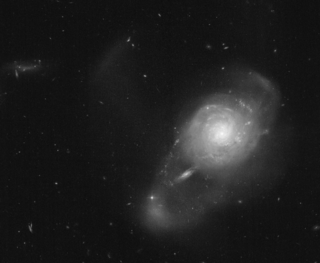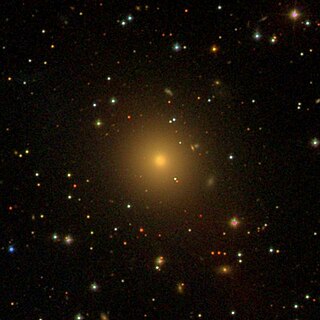The Whole Earth Blazar Telescope (WEBT) is an international consortium of astronomers created in 1997, with the aim to study a particular category of Active Galactic Nuclei (AGN) called blazars, which are characterized by strong and fast brightness variability, on time scales down to hours or less.

NGC 708 is an elliptical galaxy located 240 million light-years away in the constellation Andromeda and was discovered by astronomer William Herschel on September 21, 1786. It is classified as a cD galaxy and is the brightest member of Abell 262. NGC 708 is a weak FR I radio galaxy and is also classified as a type 2 Seyfert galaxy.

NGC 2273 is a barred spiral galaxy located in the constellation Lynx. It is located at a distance of circa 95 million light years from Earth, which, given its apparent dimensions, means that NGC 2273 is about 100,000 light years across. It was discovered by Nils Dunér on September 15, 1867.

NGC 7679 is a lenticular galaxy with a peculiar morphology in the constellation Pisces. It is located at a distance of about 200 million light years from Earth, which, given its apparent dimensions, means that NGC 7679 is about 60,000 light years across. It was discovered by Heinrich d'Arrest on September 23, 1864. The total infrared luminosity is 1011.05 L☉, and thus it is categorised as a luminous infrared galaxy. NGC 7679 is both a starburst galaxy and a Seyfert galaxy.

AP Librae is a BL Lacertae object located at a distance of 700 million light years in the southern constellation of Libra. In the visual band it is one of the most active blazars known. AP Lib is surrounded by an extended source with a spectrum characteristic of a red-shifted giant elliptical galaxy. The derived visual magnitude of this region is 15.0, and it follows a radially decreasing brightness that is characteristic of an elliptical. Seven fainter galaxies are visible within an angular radius of 9′, suggesting it is the brightest member of a galactic cluster.

NGC 4253 is a barred spiral galaxy located in the constellation Coma Berenices. It is located at a distance of about 185 million light years from Earth, which, given its apparent dimensions, means that NGC 4253 is about 65,000 light years across. It was discovered by William Herschel on February 3, 1788. It is a Seyfert galaxy.

NGC 3786 is an intermediate spiral galaxy located 107.5 million light-years away in the northern constellation of Ursa Major. It was discovered by English astronomer John Herschel on April 10, 1831. This object appears to form a close pair with its peculiar neighbor to the north, NGC 3788. They show some indications of interaction, such as minor distortion of the disk or tidal features.

IC 310 is a lenticular galaxy located in the constellation Perseus. It is located 265 million light-years from Earth, which means, given its apparent dimensions, it is about 117,000 light-years across. The galaxy was discovered by Edward D. Swift on November 3, 1888.

PKS 0438-436, also known as PKS J0440-4333, is a quasar located in constellation Caelum. With a high redshift of 2.86, the object is located 11.2 billion light-years from Earth and is classified as a blazar due to its flat-spectrum radio source, (in terms of the flux density as with α < 0.5 and its optical polarization.

PG 0844+349, also known as TON 951, is a galaxy in the southern constellation Lynx, near the border of Cancer. Its redshift is 0.064000, putting the galaxy at 849 million light-years away from Earth.

PKS 1402+044 is a quasar located in the constellation of Virgo. It has a redshift of 3.207, estimating the object to be located 11.3 billion light-years away from Earth.

PKS 0805-07 also known as PMN J0808-0751 and 4FGL J0808.2-0751, is a quasar located in the constellation of Monoceros. With a redshift of 1.83, light has taken at least 10 billion light-years to reach Earth.

MCG +08-11-011 known as UGC 3374, is a galaxy located in the constellation of Auriga. It is located 401 million light years from Earth and is classified as a Seyfert galaxy.

Markarian 1018, also known as UGC 1597, is a lenticular galaxy with a peculiar structure located in the constellation Cetus. It is located at an approximate distance of 607 million light years from Earth and has an apparent dimensions of 0.99 by 0.52 arcmin. It is classified as a change looking Seyfert galaxy and galaxy merger.

1H 0323+342 known as 2MASX J032441.19+341045.9, is a galaxy located in the constellation of Perseus. It is located 831 million light years from Earth. It is classified a gamma-ray emitting narrow-line Seyfert galaxy, the nearest known example of this subtype.

PKS 1830-211 is a gravitationally-lensed blazar in the southern constellation of Sagittarius, one of the most powerful such objects known. It has a high redshift (z) of 2.507, an indicator of its significant distance. This flat-spectrum radio quasar (FSRQ) is one of the brightest extraterrestrial radio sources. In visible light, identification of this object is hampered by the galactic plane and an M-type star that lies near the line of sight.

RX J1633.3+4718 known as RXS J16333+4718 according to VLBI Network observations, is a narrow-line Seyfert 1 galaxy, located in the constellation of Hercules. It has a redshift of (z) 0.116 and is located 1.75 billion light years from Earth. The first known reference to this galaxy comes from a radio source which was identified in 1995 in the IRAS catalogue as F16319+4725.

NRAO 530 or PKS 1730-13 is a flat-spectrum radio quasar located in the southern constellation of Serpens. It has a redshift of 0.902. and was first discovered by two astronomers, W.J. Welch and Hyron Spinrad in 1973. It is classified as a blazar because of its optical variability across the electromagnetic spectrum in radio, gamma ray and X-ray bands. This quasar is also further categorized an OVV quasar.

PKS 1424-418 is a blazar located in the constellation of Centaurus. It has a redshift of 1.522 and was first discovered in 1971 by astronomer Keith Peter Tritton who identified the object as ultraviolet-excessive. This object is also highly polarized with a compact radio source. The radio spectrum of this source appears flat, making it a flat-spectrum radio quasar.


















